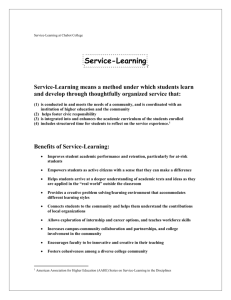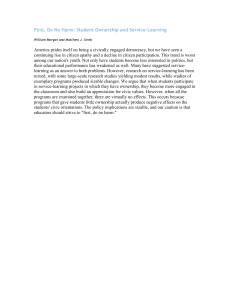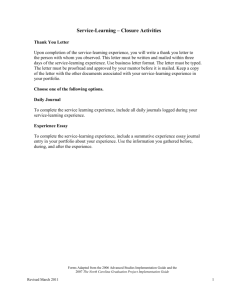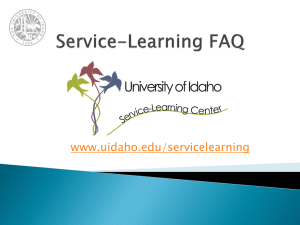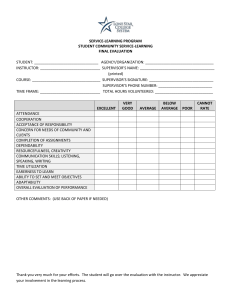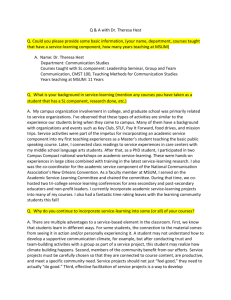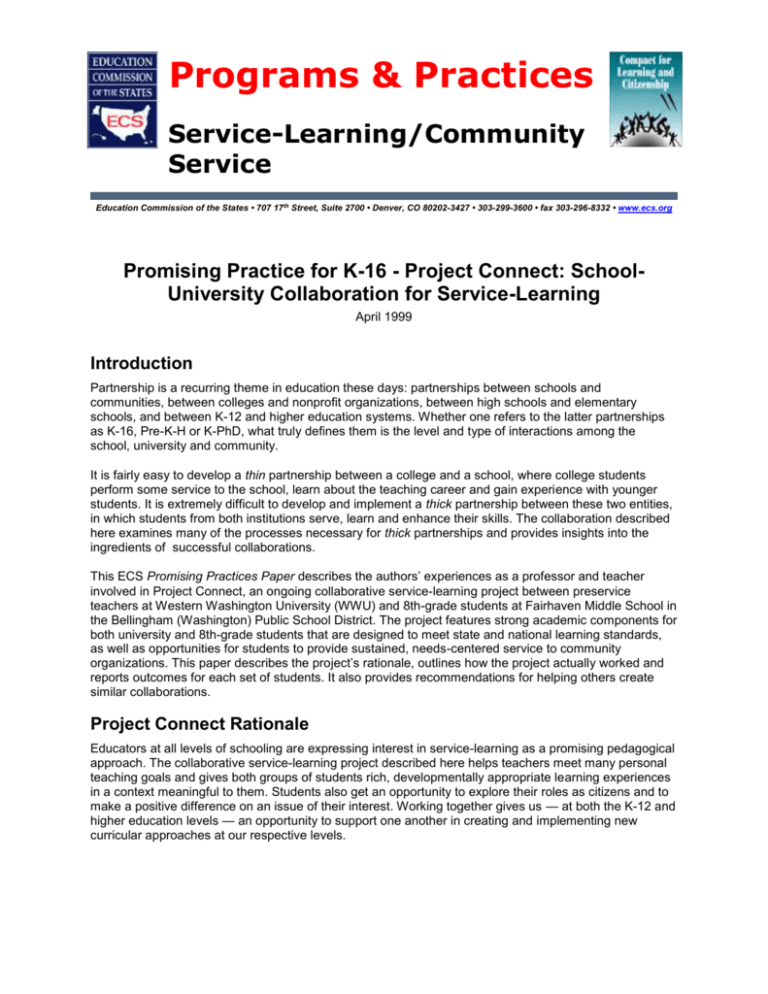
Programs & Practices
Service-Learning/Community
Service
Education Commission of the States • 707 17th Street, Suite 2700 • Denver, CO 80202-3427 • 303-299-3600 • fax 303-296-8332 • www.ecs.org
Promising Practice for K-16 - Project Connect: SchoolUniversity Collaboration for Service-Learning
April 1999
Introduction
Partnership is a recurring theme in education these days: partnerships between schools and
communities, between colleges and nonprofit organizations, between high schools and elementary
schools, and between K-12 and higher education systems. Whether one refers to the latter partnerships
as K-16, Pre-K-H or K-PhD, what truly defines them is the level and type of interactions among the
school, university and community.
It is fairly easy to develop a thin partnership between a college and a school, where college students
perform some service to the school, learn about the teaching career and gain experience with younger
students. It is extremely difficult to develop and implement a thick partnership between these two entities,
in which students from both institutions serve, learn and enhance their skills. The collaboration described
here examines many of the processes necessary for thick partnerships and provides insights into the
ingredients of successful collaborations.
This ECS Promising Practices Paper describes the authors’ experiences as a professor and teacher
involved in Project Connect, an ongoing collaborative service-learning project between preservice
teachers at Western Washington University (WWU) and 8th-grade students at Fairhaven Middle School in
the Bellingham (Washington) Public School District. The project features strong academic components for
both university and 8th-grade students that are designed to meet state and national learning standards,
as well as opportunities for students to provide sustained, needs-centered service to community
organizations. This paper describes the project’s rationale, outlines how the project actually worked and
reports outcomes for each set of students. It also provides recommendations for helping others create
similar collaborations.
Project Connect Rationale
Educators at all levels of schooling are expressing interest in service-learning as a promising pedagogical
approach. The collaborative service-learning project described here helps teachers meet many personal
teaching goals and gives both groups of students rich, developmentally appropriate learning experiences
in a context meaningful to them. Students also get an opportunity to explore their roles as citizens and to
make a positive difference on an issue of their interest. Working together gives us — at both the K-12 and
higher education levels — an opportunity to support one another in creating and implementing new
curricular approaches at our respective levels.
"I do think that my experience has changed me. I am more open to volunteering for stuff, even if it is just raising my
hand to say my opinion or give an answer. Going to the food bank has also made me thankful for what I have…. I want
to work hard so I can go to college and get a well-paying job."
– Sarah, 8th grade
Service-learning is a powerful way to enhance young adolescent learners’ cognitive, social and moral
development. Many goals set forth by the National Middle School Association’s publication, This We
Believe, as well as emerging academic standards established by state departments of education and
national teacher associations, can be effectively addressed through service-learning. Students’ cognitive
development is enhanced as they prepare for service. In conducting research about their projects,
students develop and practice the skills of acquiring, analyzing and interpreting information — goals set
forth by the National Council for the Social Studies. Additionally, for middle school students, servicelearning does the following:
■
Provides a way for students to become connected to the community
■
Gives students a chance to understand abstract concepts and international and national issues
through the study of local issues
■
Helps students become “intellectually reflective” youth who are doers and not just observers, as
called for by the Carnegie Foundation in its Turning Points report
■
Enables students to explore personal responsibilities and learn how citizens can participate in their
government — all goals established for civics education by the Center for Civic Education.
Service-learning also contributes to middle school students’ social and moral development. As students
define community needs and brainstorm solutions to problems, they learn to connect the knowledge,
skills and values they learn to positive civic action. Interacting with community agency partners and
working together on projects help students practice their communication and cooperation skills. These
opportunities for positive social interaction with adults and peers help students explore relationships in a
new context. In addition, taking action to meet the needs of their community helps connect students with
community members and reinforce pro-social behaviors.
"Regardless of my bad junior high experience, these kids seem to be really happy people. Even students who I would
have picked as ‘the rebels’ were great kids. I now know not to judge these kids. I learned that younger people are caring
more about their community and other people than the people I grew up with. I have learned to take them a lot more
seriously than I would have before."
— Jen, preservice teacher
Enhancing Preservice Teacher Education
There is also a growing interest in service-learning as a key component in teacher education programs,
partially because service-learning provides education students with extended opportunities to work with
young people. Researchers report the following benefits of incorporating service-learning into teacher
education:
■
Increased self-esteem and self-efficacy (Wade, 1995)
■
Gains in thinking complexity (Batchelder & Root, 1994)
■
More successful student teaching internships (Sullivan, 1991)
■
Increased sensitivity to diversity issues (Seigel, 1995)
■
Stronger commitment to social justice (Vadeboncoeur, et al., 1996)
■
Better understanding of the social and psychological elements children bring to the classroom
(Edwards, 1996).
Education Commission of the States • 707 17th Street, Suite 2700 • Denver, CO 80202-3427 • 303-299-3600 • fax 303-296-8332 • www.ecs.org
• Page 2 •
“Through service-learning, I have developed a higher level of communicating to strangers. It is easier to make
conversation with people I’m unfamiliar with. I think that com-munication is a great skill to master.”
– Jacob, 8th grade
Project Connect
Overview
While the project is ongoing, this section looks at the project in spring 1999. In that year, the project
lasted for just under five months (see the Timeline and Responsibilities Chart for a breakdown of tasks
over those months). The 8th-grade students did the classroom portion in a two-period integrated social
studies and language arts core class. The university students enrolled in a course titled “Seminar in
Service-Learning.” In both the university and public school classrooms, we identified community
problems, researched current events, gathered varying perspectives on issues, and explored public policy
using print and Internet resources. Students then established service action plans and spent one twohour block of time in community agencies each week for eight weeks.
Working with the Center for Service-Learning on the WWU campus, we found placements for the 23
university students and 150 8th graders involved in the project. The placements ranged from working with
city parks personnel on planting and stream rehabilitation, to working in day care centers, elderly care
facilities, the food bank, a local AIDS hospice and an animal care shelter.
Preservice teachers transported 8th-grade teams to their service sites and engaged in service activities
along with them. Both groups took part in reflective discussions on the return trips to school and followed
the trips with journal writing. The 8th-grade students completed a final project with both individual and
group components.
In this project, participants focused on several of Washington State’s essential academic learning
requirements. Through preparation, service, reflection and culminating activities, the following state goals
and objectives were addressed:
Communication
■
The student uses communication strategies and skills to work effectively with others.
■
The student communicates to a wide range of audiences for a variety of purposes.
Writing
■
The student writes clearly and effectively.
■
The student writes in a variety of forms for different audiences and purposes.
Civics
■
The student understands the rights and responsibilities of citizenship and the principles of democratic
civic involvement.
Reading
■
The student reads different materials for a variety of purposes.
“The art of questioning is a crucial skill for the teacher in this learning environment. How do you access [students’]
thoughts and feelings and help them articulate what is in their heads? I see the art of questioning as crucial in the
traditional class set-up as well.”
— Stephanie, preservice teacher
Academic preparation for the 8th-grade students began two months before their work at the service sites.
The students brainstormed potential service activities within the categories of “working with animals,” “the
Education Commission of the States • 707 17th Street, Suite 2700 • Denver, CO 80202-3427 • 303-299-3600 • fax 303-296-8332 • www.ecs.org
• Page 3 •
environment,” “working with elderly,” “working with children” and “social services.” Students were given a
choice of working on projects from these five topic areas. Once each student had chosen a topic for his or
her work, they took part in several activities to learn more about their topics.
From the outset of the project, the middle school students were required to compile a collection of current
events reports related to their service topic areas. Students studied current events in the newspaper, on
the radio, television and Internet to help them become familiar with issues. They then conducted research
by locating pertinent legislation at the U. S. Congress World Wide Web site. Prepared with information
from the media and their Internet searches, students drafted legislation pertaining to their issues which
they then discussed in a mock Congress.
Collaborative Service and Reflection Activities
On service days, students reported to their core class, recorded journal questions to be addressed and
left for the site with their adult volunteers (either preservice teachers or parents). Before these adult
volunteers were allowed to drive and chaperone students, they underwent a fingerprinting background
check required by the state and were given information on sexual harassment. They also signed forms
indicating they had private vehicle insurance. Additionally, students were required to return a field trip
permission form signed by their parent or guardian.
Project Connect Timeline and Responsibilities Chart
Date
Fairhaven Middle School
Responsibilities
Shared Responsibilities
Western Washington University
Responsibilities
January
* Identify essential learning
requirements to be met
* Meet with district servicelearning coordinator
* Administer pretest to 8th graders
* Introduce service-learning in
core classes
* Brainstorm issue topics with
students and identify student
interest areas
* Identify theme areas
* Begin current issues discussions
* Define project goals
* Meet with Center for ServiceLearning (CSL) staff to describe
project
* Call potential sites, work with
CSL to identify and contact others
* Meet with CSL to initiate project
contact
* Construct pretest
* Visit potential sites
* Create packet to distribute to sites
describing project
* Create curriculum for seminar in
service-learning
February
* Continue current events
discussions
* Plan congressional simulation
* Continue contacting sites
* Research Web sites to use with 8th
graders
* Pre-visit sites
March
* Do congressional simulation
* Research service-learning topics
on the Web
* Host guest panel of experts in
topic areas
* Identify parent volunteers to
chaperone at sites
* Begin mapping site chart with
times and students who will go to
each site
* Distribute and collect district
volunteer forms
* Create master schedule of
volunteers, sites, students
* Create individual site sheets
with names of contact people,
students, driver, driving directions
and emergency phone numbers
* Identify and contact potential
guest speakers
* Promote service-learning opportunity
in university classes
* Identify university student
participants
* Confirm with sites
* Begin service-learning seminar,
spring quarter
* Administer pretest to university
students
April
* Begin service-learning field
activities
* Do weekly reflective writing
* Greet volunteers and help them
find the classroom
* Introduce drivers and students,
* Continue seminar
* Do weekly reflective writing
* Troubleshoot and problem solve
Education Commission of the States • 707 17th Street, Suite 2700 • Denver, CO 80202-3427 • 303-299-3600 • fax 303-296-8332 • www.ecs.org
• Page 4 •
Date
May
Fairhaven Middle School
Responsibilities
Shared Responsibilities
Western Washington University
Responsibilities
* Create final project rubrics
* Identify and work on final project
topics
coordinate departure from school
* Visit sites
* Check progress with sites
* Create post-tests
* Continue service activities and
reflection
* Present final projects
* Administer post-test
* Celebrate!
* Plan final celebration
* Continue service activities and
reflection
* Attend project presentations and
celebration
* Administer post-tests
Travel time to and from the sites was used as an educational opportunity. Students and adults discussed
events and raised questions to be answered during their time at the site. The 8th graders and preservice
teachers then spent their time on site working side by side, providing services needed by the agencies and
organizations with whom they worked.
(Before service-learning)
“I don’t really see myself as a community servant outside of school because I have a busy life, I’m lazy, and I don’t feel
a very strong need to go out and clean up in my spare time.”
(Same student after service-learning)
“I guess this experience has helped me understand how lonely old people are that are in nursing homes, and to
understand what it must be like for them. I think it may have made me a little happier, giving me something to do. Also,
it’s given me a reason to go to school on Wednesdays. Before it was just like every other boring, pointless day, and I
didn’t want to get up in the morning.”
— 8th grade girl
Because reflection is the key component that leads to the learning in service-learning, education students
and 8th graders engaged in reflective discussions as they returned from their site visits each week.
Together, the students talked about what they did and how their activities and observations related to
weekly news and the research they had conducted about local issues. The middle school students were
required to write reflective journal entries each time they returned from their site. Students described the
sites and the people they met there, analyzed how they made a difference at their site, reported on career
possibilities they had learned about and explained how their experience had changed them.
In addition, they responded to questions or “journal prompts” that gave them a specific focus for learning
each time they went into the field. The following are a few examples of journal prompts used with the 8thgrade students:
■
How is this experience meaningful and relevant to you?
■
What did you learn about yourself today?
■
What have you learned about career possibilities related to your site?
■
How has your experience changed you?
Writing about their experience gave students the opportunity to practice written communication skills in
addition to helping them process their learning. Journal entries were collected and counted toward the
students’ final unit grades.
Education Commission of the States • 707 17th Street, Suite 2700 • Denver, CO 80202-3427 • 303-299-3600 • fax 303-296-8332 • www.ecs.org
• Page 5 •
“For a number of years, the Bellingham Public Schools have benefited from the participation of Western Washington
University students in collaborative efforts to support student learning at all levels. The Fairhaven Middle School
service-learning project is an outstanding example of how this university-school partnership can work to enhance
learning for all of the involved students. In the school district, we are especially appreciative of university faculty
initiatives to work with our teachers and administrators to design learning projects which give university students handson experiences while providing younger students expanded opportunities for learning support. Project Connect at
Fairhaven offers a service-learning experience for both middle school and university students.
“Our school district has a clear mission and focus on maximizing learning and teaching in our schools and on providing
safe, supportive learning environments for students. Service-learning projects like Project Connect require our students
to apply and integrate their knowledge and to use basic skills to complete a real task. This project focuses student work
on academic objectives while engaging young adolescents in meaningful work and service. The evidence shows that
students gain academically, socially and emotionally from these experiences. This project provides a framework for real
growth as a learner, as a communicator and as a citizen.”
— Dale Kinsley, superintendent, Bellingham (Washington) Public Schools
In addition to the project presentation, the 8th-graders’ accomplishments were celebrated through the
creation of a public display of photographs for the middle school lobby, providing a sense of
accomplishment and recognition for students. Selected photographs are also on display in the university’s
Department of Secondary Education and the Center for Service-Learning.
Outcomes
This project brought out the best in both the 8th-grade and college students. When a director of one of the
elderly care facilities suggested one student might bring in something related to his interest in baseball,
the student returned the next week with a framed collage of pictures which he shared with residents.
Other students gained a concrete sense of accomplishment when the seedlings they planted at the
beginning of their project showed substantial growth by the end of their time in the field. Preservice
teachers returned with excitement from working with 8th graders, expressing confidence that they would
be successful as teachers. Putting students in the role of helping others — whether younger students,
animals or persons in need of health care — gave some of them a confidence that would be difficult to
draw out in more traditional classroom settings.
“The thing I learned about myself today is that I can bring happiness and joy to others by doing the simplest task in the
world — visiting and talking with people who rarely have that opportunity.”
— Enoch, 8th grade
Several students said they would like to continue their community service, which serves as an inspiration
to the adults involved. It is refreshing and exciting to work with students who want to explore their positive
potential, and service-learning is an excellent way to help them discover what they can do. Through a
systematic analysis of the reflective journals written by the students, analysis of the videotapes of their
presentations, discussions and our own observations of the students’ growth, teachers saw a tremendous
positive impact from their service-learning experiences.
Specifically, 8th graders realized the following learning outcomes:
■
Increased communication skills
■
Greater knowledge of community issues and agencies
■
Career goal clarification
■
Awareness of the responsibilities of citizenship.
“Service-learning is a tool that can effect a powerful change in students. It can reach the ‘unreachsable’ student and
help those students to learn who learn best by nontraditional or hands-on methods.”
– Kyle, preservice teacher
Education Commission of the States • 707 17th Street, Suite 2700 • Denver, CO 80202-3427 • 303-299-3600 • fax 303-296-8332 • www.ecs.org
• Page 6 •
An analysis of the weekly reflections and pretest and post-test questionnaires indicated that the
preservice teachers also gained from the project in many ways, including the following:
■
Hands-on knowledge of how to use service-learning in classrooms
■
Enhanced teaching skills
■
Greater understanding of middle school students
■
Increased use of media to follow current events.
Challenges and Benefits of Collaboration
Although either of us could have conducted service-learning projects without the other, we found that
connecting these two levels of students increased the impact of the project overall. Making the
collaboration work for both levels of students required careful and thoughtful planning and a high level of
attention to detail. As leaders, we met several times to outline project goals and objectives for each set of
students, to define tasks and responsibilities, and to align the curriculum and school calendars for 8thgrade and college classes.
“I think I will do volunteer work in the future because I think it is important for teens to get involved in something other
than their own personal lives. I think a few teenagers give our whole social class a bad name. I want people to realize
that not all kids are self-centered and troublesome.”
— Betsy, 8th grade
Among the challenges we faced were the following:
■
Finding enough time to plan together
■
Matching university and middle school schedules and calendars
■
Working within the time constraints of a two-period middle school core
■
Creating buy-in for service-learning at both levels of schooling
■
Aligning curriculum and activities to meet the needs of both middle school and preservice teacher
curricula simultaneously.
Each challenge was addressed as it arose. Creative scheduling and continued open dialogue allowed us
to identify and overcome each potential obstacle. The learning for both groups of students was enhanced
through their interaction with one another — each group brought a unique perspective to the project and
helped the other to reflect on events and experiences from a different vantage point.
We observed the following benefits for students:
■
Preservice teachers provided positive adult role models for 8th-grade students.
■
Eighth-grade students gave the preservice teachers a heightened appreciation for and understanding
of the capabilities of middle-level learners.
■
The collaboration gave preservice teachers an additional opportunity to work in schools.
■
Increased numbers of drivers and chaperones enabled the middle school to use more service sites,
which enabled 8th graders to have more control over their choices and therefore their learning.
■
By serving and reflecting together, each group of students gained perspectives from the other.
As teachers, we also derived a number of benefits from our collaboration, including the
following:
■ Sharing responsibility for a complex learning/teaching approach
■
Becoming confident in our ability to orchestrate complicated logistical details
Education Commission of the States • 707 17th Street, Suite 2700 • Denver, CO 80202-3427 • 303-299-3600 • fax 303-296-8332 • www.ecs.org
• Page 7 •
■
Strengthening each component of middle school and preservice teacher curricula by sharing teaching
insights with each other
■
Gaining personal satisfaction from teaching meaningful and relevant skills and information
■
Becoming re-energized through innovating the curriculum.
“I have learned the most about what a huge impact this type of project can have on the students, their long-term
education, their outlook on life and attitudes towards those in need, the community’s perceptions of youth, and myself.”
— Marcie, pre-service teacher
Supporting Collaborative Service-Learning
To facilitate the development of Project Connect, we received strong support from both the Bellingham
school district and the university. Perhaps most important, both schools gave us the freedom to try this
innovative approach. Beyond that, Western Washington University supported the project by providing
money to attend conferences related to service-learning prior to designing the project and a reduced
teaching load during the quarter in which the actual project occurred. The university’s Center for ServiceLearning also helped contact community partners and find places for the service fieldwork.
Both the middle school and district administrators supported efforts to implement this project and helped
explain the project to other faculty and parents. They also supported travel to national conferences where
we have discussed this project. After the initial year of the project, participation in the Washington State
Contextual Teaching and Learning Consortium — a federally funded project located at the University of
Washington — helped us refine and further build our components. Without these strong levels of support,
it would have been much more difficult to implement this complicated project successfully.
"Unlike the classroom where learning tends to be abstract, historical or literary, service-learning becomes a powerful
and real experience for students. Additionally, in practicing democratic responsibility, students learn about their own
value to the society. This strengthens motivation, interests and self-power."
— Deirdre O’Neill, principal, Fairhaven Middle School, Bellingham, Washington
Suggestions for Developing Collaborative Relationships
To develop collaborative partnerships, universities and school districts need to communicate about their
individual and mutual goals. University professors can work with district offices and school faculty to
identify needs and play a supportive role in helping schools establish service-learning projects. Teachers
can contact preservice teacher institutions to determine which faculty might share their interest in
collaborating. Attending or providing inservice workshops can help university faculty and K-12 teachers
make connections.
Once a collaborative partner has been identified, the following recommendations will help establish a
smooth working relationship:
■
Provide preservice and inservice teacher training on the pedagogy of service-learning
■
Provide released time for planning to create collaborative relationships
■
Clearly define roles for community agency, university and school personnel
■
Provide support to help teachers make community contacts
■
Become aware of and address university and district legal requirements
■
Recognize that collaborative projects are built through a number of stages and allow time for
components to be developed, refined and improved
■
Provide recognition for both teachers and university professors who engage in innovative
collaborations.
Education Commission of the States • 707 17th Street, Suite 2700 • Denver, CO 80202-3427 • 303-299-3600 • fax 303-296-8332 • www.ecs.org
• Page 8 •
The following steps can help ensure a quality service-learning experience for both middle school students
and preservice teachers:
■
Allow students the opportunity to choose their service topic/site
■
Provide ample time for processing learning and bringing the project to closure
■
Use a variety of reflection techniques and use reflections to guide student learning
■
Give preservice teachers both classroom and field-based experiences during service projects.
Conclusion
Working in a school district and university system that value service-learning highly was of utmost
importance. The school district has identified service-learning as a key component in its Middle Schools
of the Future position statement; the university acknowledges the role of service-learning in its
institutional mission statement. The opportunity to share the project at inservice workshops and
professional conferences to the enthusiastic response of our colleagues has proved invaluable. Given the
depth of learning observed in the students who took part, the response from community organizations
and parents, and our own personal satisfaction, we will continue to refine the curriculum and provide this
learning experience for middle school and preservice students .
"Project Connect offers a comprehensive model of what service-learning can be — a truly integrated, collaborative
endeavor where students work with community to define needs, reflection is integrated throughout the project, and
deep, sustainable partnerships are developed. Project Connect also brings WWU's commitment to youth to fruition by
increasing opportunities for Western students to serve children and youth."
– Lisa Moulds, program manager, Center for Service Learning, Western Washington University
"This project is precisely the kind of collaboration Western Washington University endorses and sponsors. I am pleased
that our Center for Service Learning could assist in this project, and I am looking forward to many more collaborative
endeavors such as this. Through the successful implementation and dissemination of results of service-learning
collaborations such as Project Connect, I am confident that an expanding number of students at Western will be able to
participate in community-based service-learning experiences and that our faculty will increasingly see the merits of
these community-university connections."
– Kris Bulcroft, Center for Innovative Instruction, Western Washington University
References
Batchelder, Thomas H., and Susan Root (1994, August). “Effects of an Undergraduate Program To
Integrate Academic Learning and Service: Cognitive, Prosocial Cognitive and Identity Outcomes.”
Journal of Adolescence, vol. 17, no. 4, pp 341-55.
Carnegie Council On Adolescent Development (1995). Turning Points: Preparing American Youth for the
21st Century. New York, NY: Carnegie Corporation.
Center for Civic Education (CCE) (1994). National Standards for Civics Education. Calabasas, CA: CCE.
Council of Chief State School Officers (CCSSO) (1995). Integrating Service-Learning into Teacher
Education: Why and How? Washington, DC: CCSSO.
Edwards, June (1996, November). “A Dose of Reality for Future Teachers.” Educational Leadership, vol.
54, no. 3, pp. 56-57.
Erickson, Joseph A., and Jeffrey B. Anderson (Eds.) (1997). Learning with the Community: Concepts
and Models for Service-Learning in Teacher Education. Washington, DC: American Association for
Higher Education.
Education Commission of the States • 707 17th Street, Suite 2700 • Denver, CO 80202-3427 • 303-299-3600 • fax 303-296-8332 • www.ecs.org
• Page 9 •
National Council for the Social Studies (NCSS) (1994). Expectations for Excellence: Curriculum
Standards for Social Studies. Washington, DC: NCSS.
National Middle School Association (NMSA) (1995). This We Believe: Developmentally Responsive
Middle Level Schools. Columbus, OH: NMSA.
National Middle School Association (1991). NCATE-Approved Curriculum Guidelines. Columbus, OH:
NMSA.
Seigel, Susan (1995). Community Service-Learning as Empowering Pedagogy: Implications for Middle
School Teachers. Unpublished doctoral dissertation. Amherst, MA: University of Massachusetts.
Sullivan, R. (1991, February). The Role of Service-Learning in Restructuring Teacher Education. Paper
presented at the annual meeting of the Association of Teacher Educators, New Orleans. Unpublished.
Vadeboncoeur, Jennifer A., et al. (1996, February). “Building Democratic Character Through Community
Experiences In Teacher Education.” Education and Urban Society, vol. 28, no 2, pp. 189-207.
Wade, Rahima (1995). “Developing Active Citizens: Community Service Learning in Social Studies
Teacher Education.” Social Studies, vol. 86, no. 3, pp. 122-128.
Wade, R. (1997). “Service-Learning in Preservice Teacher Education.” In Wade, R. (Ed.) Community
Service-Learning: A Guide to Including Service in the Public School Curriculum. Albany, NY: State
University of New York Press.
Resources/Organizations
The following organizations are resources for service-learning materials, curriculum and/or training and
technical assistance services.
Education Commission of the States • 707 17th Street, Suite 2700 • Denver, CO 80202-3427 • 303-299-3600 • fax 303-296-8332 • www.ecs.org
• Page 10 •
Compact for Learning and Citizenship
Education Commission of the States
www.ecs.org
303-299-3644
Campus Compact
www.compact.org
401-863-1119
Center for Human Resources
Brandeis University
heller.brandeis.edu/chr
781-736-3770
Chronicle of Philanthropy
www.philanthropy.com
202-466-1200
Close-Up Foundation
www.flint.lib.mi.us/closeup/home.html
800-CLOSE-UP
Constitutional Rights Foundation
www.crf-usa.org
213-487-5590
Corporation for National Service
www.nationalservice.org
202-606-5000
Education Week
www.edweek.org
301-280-3100
Institute for Justice
www.ij.org
202-955-1300
Learning In Deed: Making a Difference Through
Service-Learning
An Initiative of the W.K. Kellogg Foundation
www.learningindeed.org
202-778-1040
National Dropout Prevention Center
www.dropoutprevention.org
864-656-2599
National Peer-Based Service-Learning Training &
Technical Assistance Exchange
www.lsaexchange.org.
877-572-3924
National Service-Learning Clearinghouse
www.nicsl.coled.umn.edu
800-808-SERV
National Society for Experiential Education
www.nsee.org
703-933-0017
National Youth Leadership Council
www.nylc.org
651-631-3672
Northwest Regional Educational Laboratory
www.nwrel.org
800-361-7890
Points of Light Foundation
www.pointsoflight.org
202-729-8000
RMC Research
www.rmcdenver.com
303-825-3636
About the Authors
Angela Harwood is an assistant professor of secondary education at Woodring College of Education,
Western Washington University.
Callie Underhill is an 8th-grade language arts and social studies teacher at Fairhaven Middle School in
Bellingham, Washington.
Education Commission of the States • 707 17th Street, Suite 2700 • Denver, CO 80202-3427 • 303-299-3600 • fax 303-296-8332 • www.ecs.org
• Page 11 •
For More Information
The Compact for Learning and Citizenship (CLC), a project of the Education Commission of the States,
provides K-12 school leaders, legislators and other education stakeholders with resources, profiles and
strategies to integrate service-learning through practice and policy. District superintendents and chief state
school officers are invited to join. The CLC Web site (www.ecs.org) also provides links to other
organizations, clearinghouses, publications and resources. Contact Terry Pickeral, project director, at 303299-3636 or tpickeral@ecs.org, or Lou Myers, project coordinator, 303-299-3644 or lmyers@ecs.org.
Funding for this publication was generously provided by the W.K. Kellogg Foundation.
© Copyright 1999 by the Education Commission of the States (ECS). All rights reserved.
The Education Commission of the States is a nonprofit, nationwide organization that helps state leaders shape education policy. It is
ECS policy to take affirmative action to prevent discrimination in its policies, programs and employment practices.
To request permission to excerpt part of this publication, either in print or electronically, please fax a request to the attention of the
ECS Communications Department, 303-296-8332 or e-mail ecs@ecs.org.
Education Commission of the States • 707 17th Street, Suite 2700 • Denver, CO 80202-3427 • 303-299-3600 • fax 303-296-8332 • www.ecs.org
• Page 12 •

